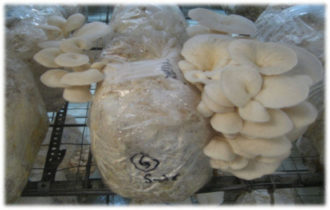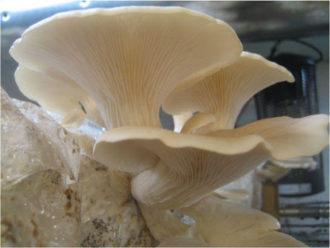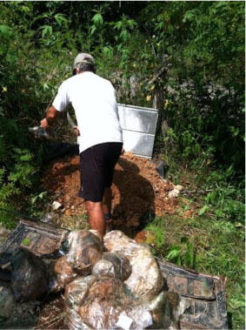ASHEVILLE, North Carolina – A mushroom production and supply facility in Asheville, NC has had success in growing tree oysters on 100 percent waste stream substrates in a closed loop system.
Though not as productive or biologically efficient as the commercial standard substrate, the waste substrates may provide a more cost-effective alternative for mushroom growers and farmers interested in more sustainable mushroom production practices.
Asheville Fungi is a mycological supply, sterile lab and grow facility whose goal is to grow edible and medicinal mushrooms on waste substrates that would otherwise end up in landfills.
In the Southern Sustainable Agriculture Research & Education (SSARE) Producer Grant (FS13-268), “Closed Loop Mushroom Production on 100 Percent Waste Substrate,” the project participants compared four waste substrates (coffee grounds, cacao shells, soy dust and husks and malt grain fines and beards) to the industry standard of oak fuel pellets, wheat bran and gypsum.
“The research study determined which waste stream products were viable substitutes for commercial substrates,” said mushroom grower Joseph Allawos.
In the study, the waste stream substrates, which are high in nitrogen, replaced the bran in the commercial standard substrate, and sawdust, high in carbon and lignin, was mixed with the waste substrates as a replacement for the hardwood fuel pellets found in the commercial standard.
Results of the two-year study found that among the waste stream substrates, cacao shells had the highest average weight harvested per bag at 1.32 pounds and an estimated dry weight biological efficiency of 66 percent during a 90-day harvest period. The soy dust and husk had an average weight harvested per bag of .89 pounds and an estimated dry weight biological efficiency of 44.5 percent, while the spent coffee grounds had an average weight harvested per bag of .81 pounds and an estimated dry weight biological efficiency of 40.5 percent. The crop failed on the malt grain fines and beards.
Compared to the commercial standard, the waste stream substrates fell short. The standard mix had an average weight harvested per bag at 2.15 pounds and dry weight biological efficiency of 107 percent.
“Although the commercial substrate mixture outperformed all of the waste stream substrates, we believe that this is due to the quality of the sawdust, and the enriching agents,” said Allawos. “Mixed sawdust likely contains a percentage of softwood or rot-resistant species and this would have an impact on overall productivity.”
The project participants documented some production difficulties associated with the waste stream substrates, including varying moisture content, little control over sawdust species, potential contamination issues not found in commercial substrates, and a longer spawn run and fruiting time compared to commercial substrates.
However, a cost analysis comparing the commercial standard to the waste substrates found that the cost to run bags of waste substrate was 59 percent to 73 percent cheaper than the cost to run bags of the commercial formulation.
“Aside from the cost associated with picking up the waste substrates, they are generally a free alternative source,” said Allawos. “They provide a local source for the growers, are typically available year-round, and are a great alternative for growers on a tight budget.”
Although the commercial standard substrate is convenient and generally produces consistent results, Allawos said that the growers have to buy the ingredients and pay the costs of shipping, certain ingredients may be unavailable during certain times of the year, and depending on sourcing, the ingredients may not be environmentally friendly.
“Growing mushrooms can be a challenge due to the unpredictability of working with fungi,” said Allawos. “But our research will help future growers to better understand and predict the implications and outcomes of using waste stream substrates as a substitute for commercial substrate mixes."
Other project participants included Chris Parker, Asheville Fungi cultivation manager; and Jennifer Rattigan, Asheville Fungi project coordinator. The waste stream substrates were provided by Bee Tree Hardwoods, Clingman Café, Smiling Hara Tempeh, French Broad Chocolates, and Riverbend Malt House.
--30—
Published by the Southern Region of the Sustainable Agriculture Research and Education (SARE) program. Funded by the USDA National Institute of Food and Agriculture (NIFA), Southern SARE operates under cooperative agreements with the University of Georgia, Fort Valley State University, and the Kerr Center for Sustainable Agriculture to offer competitive grants to advance sustainable agriculture in America's Southern region. This material is based upon work that is supported by the National Institute of Food and Agriculture, U.S. Department of Agriculture, through Southern Sustainable Agriculture Research and Education, under sub-award number: FS13-268. USDA is an equal opportunity employer and service provider. Any opinions, findings, conclusions, or recommendations expressed in this publication are those of the author(s) and do not necessarily reflect the view of the U.S. Department of Agriculture.


